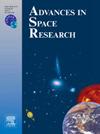Discovered a new open cluster near the poorly studied Majaess 190
IF 2.8
3区 地球科学
Q2 ASTRONOMY & ASTROPHYSICS
引用次数: 0
Abstract
We present the results of a comprehensive astrophysical study of a newly discovered open cluster, dubbed Ash-1. Using the third data release of the Gaia space mission, Gaia DR3, Ash-1 was accidentally discovered within the constellation Sagittarius in the field of the poorly studied cluster Majaess 190. Here we present the first estimates of these two clusters’ primary astrophysical properties. The membership probabilities > 0.50 were assigned to both clusters using the pyUPMASK technique. The distances were determined using the parallaxes of the clusters’ members, which were consistent with the isochrone fitting of the color-magnitude diagrams. The ages and distances of Majaess 190 and Ash-1 are found to be 4 ± 0.05 Gyr and 630 ± 20 Myr; 2130 and 1360 (±80) pc, respectively. The extinctions, heliocentric distances, mass function, luminosity function, and overall masses of the studied clusters were also computed. Based on the relaxation times, it appears that both clusters are in a state of dynamic relaxation.
在研究不足的Majaess 190附近发现了一个新的疏散星团
我们展示了对一个新发现的开放星团(被称为Ash-1)的综合天体物理学研究结果。利用盖亚太空任务第三次发布的数据--盖亚DR3,Ash-1被意外发现于人马座内研究较少的Majaess 190星团的星域中。在此,我们首次对这两个星团的主要天体物理特性进行了估计。使用 pyUPMASK 技术为这两个星团分配了大于 0.50 的成员概率。距离是利用星团成员的视差确定的,视差与色-星等图的等距拟合一致。结果发现,Majaess 190 和 Ash-1 的年龄和距离分别为 4 ± 0.05 Gyr 和 630 ± 20 Myr;2130 和 1360 (±80) pc。还计算了所研究星团的灭绝、日心距离、质量函数、光度函数和总质量。根据弛豫时间,这两个星团似乎都处于动态弛豫状态。
本文章由计算机程序翻译,如有差异,请以英文原文为准。
求助全文
约1分钟内获得全文
求助全文
来源期刊

Advances in Space Research
地学天文-地球科学综合
CiteScore
5.20
自引率
11.50%
发文量
800
审稿时长
5.8 months
期刊介绍:
The COSPAR publication Advances in Space Research (ASR) is an open journal covering all areas of space research including: space studies of the Earth''s surface, meteorology, climate, the Earth-Moon system, planets and small bodies of the solar system, upper atmospheres, ionospheres and magnetospheres of the Earth and planets including reference atmospheres, space plasmas in the solar system, astrophysics from space, materials sciences in space, fundamental physics in space, space debris, space weather, Earth observations of space phenomena, etc.
NB: Please note that manuscripts related to life sciences as related to space are no more accepted for submission to Advances in Space Research. Such manuscripts should now be submitted to the new COSPAR Journal Life Sciences in Space Research (LSSR).
All submissions are reviewed by two scientists in the field. COSPAR is an interdisciplinary scientific organization concerned with the progress of space research on an international scale. Operating under the rules of ICSU, COSPAR ignores political considerations and considers all questions solely from the scientific viewpoint.
 求助内容:
求助内容: 应助结果提醒方式:
应助结果提醒方式:


